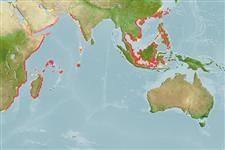>
Anguilliformes (Eels and morays) >
Ophichthidae (Snake eels) > Ophichthinae
Etymology: Ophichthus: Greek, ophis = serpent + Greek, ichthys = fish (Ref. 45335).
Environment: milieu / climate zone / depth range / distribution range
Écologie
marin; saumâtre démersal; profondeur 0 - 22 m (Ref. 3972). Tropical; 31°N - 35°S, 26°E - 127°E
Indo-Pacific: Kenya south to Madagascar and South Africa, and east to Taiwan, Thailand (Ref. 1632), and the Philippines.
Taille / Poids / Âge
Maturity: Lm ? range ? - ? cm
Max length : 100.0 cm TL mâle / non sexé; (Ref. 47613); poids max. publié: 83.30 g (Ref. 124725)
Description synthétique
Clés d'identification | Morphologie | Morphométrie
Pale brownish yellow, lighter on fins (Ref. 3972).
Occurs from shore to 22 m depth.
Life cycle and mating behavior
Maturities | Reproduction | Spawnings | Egg(s) | Fecundities | Larves
McCosker, J.E. and P.H.J. Castle, 1986. Ophichthidae. p. 176-186. In M.M. Smith and P.C. Heemstra (eds.) Smiths' sea fishes. Springer-Verlag, Berlin. (Ref. 3972)
Statut dans la liste rouge de l'IUCN (Ref. 130435)
Menace pour l'homme
Harmless
Utilisations par l'homme
Pêcheries: sans intérêt
Outils
Articles particuliers
Télécharger en XML
Sources Internet
Estimates based on models
Preferred temperature (Ref.
123201): 24.7 - 29.1, mean 28.5 °C (based on 1098 cells).
Phylogenetic diversity index (Ref.
82804): PD
50 = 0.5000 [Uniqueness, from 0.5 = low to 2.0 = high].
Bayesian length-weight: a=0.00056 (0.00029 - 0.00108), b=3.04 (2.87 - 3.21), in cm total length, based on LWR estimates for this species & (Sub)family-body (Ref.
93245).
Niveau trophique (Ref.
69278): 4.1 ±0.7 se; based on size and trophs of closest relatives
Résilience (Ref.
120179): Milieu, temps minimum de doublement de population : 1,4 à 4,4 années (Preliminary K or Fecundity.).
Fishing Vulnerability (Ref.
59153): High vulnerability (60 of 100).
